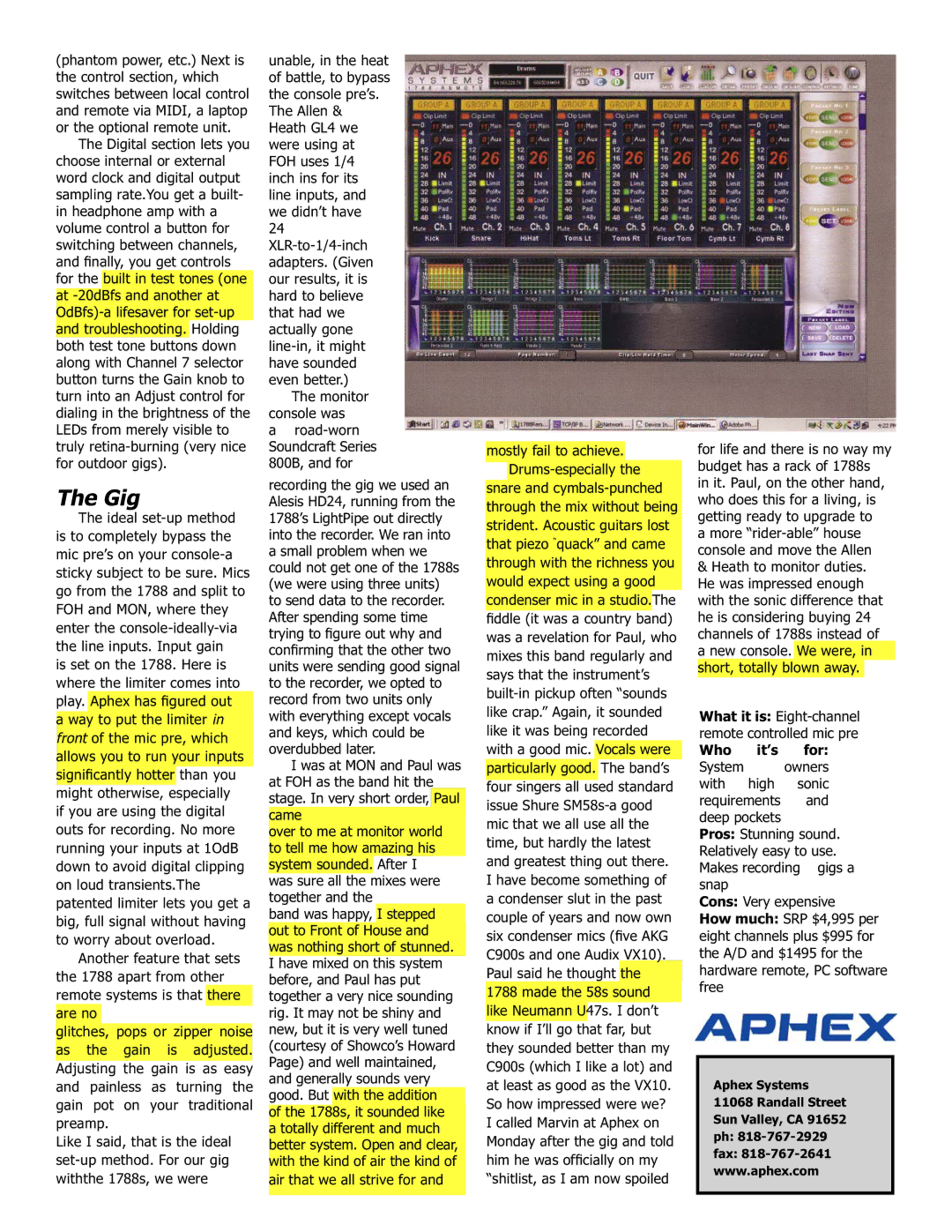
(phantom power, etc.) Next is the control section, which switches between local control and remote via MIDI, a laptop or the optional remote unit.
The Digital section lets you choose internal or external word clock and digital output sampling rate.You get a built- in headphone amp with a volume control a button for switching between channels, and finally, you get controls for the built in test tones (one at
The Gig
The ideal
is set on the 1788. Here is where the limiter comes into play. Aphex has figured out a way to put the limiter in front of the mic pre, which allows you to run your inputs significantly hotter than you might otherwise, especially if you are using the digital outs for recording. No more running your inputs at 1OdB down to avoid digital clipping on loud transients.The patented limiter lets you get a big, full signal without having to worry about overload.
Another feature that sets the 1788 apart from other remote systems is that there are no
glitches, pops or zipper noise as the gain is adjusted. Adjusting the gain is as easy and painless as turning the gain pot on your traditional preamp.
Like I said, that is the ideal
unable, in the heat of battle, to bypass the console pre’s.
The Allen & Heath GL4 we were using at FOH uses 1/4 inch ins for its line inputs, and we didn’t have 24
The monitor console was
a
recording the gig we used an Alesis HD24, running from the 1788’s LightPipe out directly into the recorder. We ran into a small problem when we could not get one of the 1788s (we were using three units) to send data to the recorder. After spending some time trying to figure out why and confirming that the other two units were sending good signal to the recorder, we opted to record from two units only with everything except vocals and keys, which could be overdubbed later.
I was at MON and Paul was at FOH as the band hit the stage. In very short order, Paul came
over to me at monitor world to tell me how amazing his system sounded. After I was sure all the mixes were together and the
band was happy, I stepped out to Front of House and was nothing short of stunned. I have mixed on this system before, and Paul has put together a very nice sounding rig. It may not be shiny and new, but it is very well tuned (courtesy of Showco’s Howard Page) and well maintained, and generally sounds very good. But with the addition of the 1788s, it sounded like a totally different and much better system. Open and clear, with the kind of air the kind of air that we all strive for and
mostly fail to achieve.Drums-especially the
snare and
1788 made the 58s sound like Neumann U47s. I don’t know if I’ll go that far, but they sounded better than my C900s (which I like a lot) and at least as good as the VX10. So how impressed were we? I called Marvin at Aphex on Monday after the gig and told him he was officially on my “shitlist, as I am now spoiled
for life and there is no way my budget has a rack of 1788s in it. Paul, on the other hand, who does this for a living, is getting ready to upgrade to
amore
anew console. We were, in short, totally blown away.
What it is: Eight-channel remote controlled mic pre
Who it’s for:
System owners with high sonic requirements and deep pockets
Pros: Stunning sound. Relatively easy to use. Makes recording gigs a snap
Cons: Very expensive
How much: SRP $4,995 per eight channels plus $995 for the A/D and $1495 for the hardware remote, PC software free
Aphex Systems 11068 Randall Street Sun Valley, CA 91652 ph:
